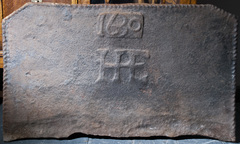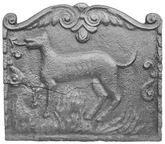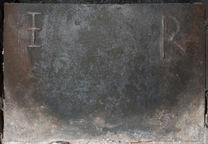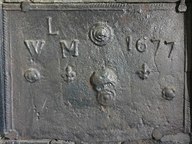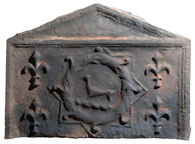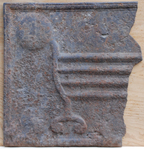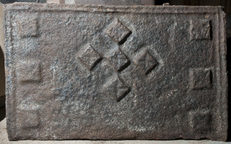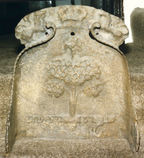-
1229
Description: Rectangular with canted top corners; twisted rope edging (top and sides); top centre, date formed from a single stamp, over-pressed; monogram below date.
Notes: Dates formed from a single stamp are uncommon, this series being distinguished by this practice. Formerly at a house in Rochester. Bentley Auctioneers, Cranbrook, lot 889, 4 Jun 2022 (£130).
Inscription: 1630 / HPE
- Decoration tags:
- rectangular with canted top corners (shape)
- rope (edging)
- carved stamps
- date stamp
- monogram
- text
Manufactured: in 1630 in the Weald area of England.
Current location: not known.
- Attached to series:
- 1630s HPE series
-
851
Description: Rectangular with mirrored floriate scrolled top; simulated overlapping tile edging at sides, with fillet bottom edge; a mythical salamander in the form of a dog with an arrow-shaped tongue, standing among flames; a stapled scroll inside the left and right edges.
Notes: This fireback was used to create a composite fireback design on a plate at Rivers Farmhouse, Ardingly (no. 13).
- Decoration tags:
- rectangular (shape)
- simulated overlapping tile (edging)
- whole carved pattern
- mythological
- animals
- objects
Manufactured: in the mid-17th century in the Weald area of England.
Current location: not known.
Citation: Lloyd, N., 1925, 'Domestic Ironwork I', Architectural Review, 58, pp. 58-67.
- Attached to series:
- Stapled scroll series
- Brede group
-
221
Description: Rectangular; plain plate; inscription in capitals split between top corners, ‘I’ crossed.
Notes: The letters are likely to have been formed by tracing their shape in the casting sand using a pointed implement.
Inscription: I R
- Decoration tags:
- rectangular (shape)
- none (edging)
- individual letters
- text
Manufactured: in the early-17th century in the Weald area of England.
Current location: in private hands, Buxted, East Sussex, England.
- Attached to series:
- Initials only firebacks
-
306
Description: Rectangular; twisted rope edging (top and sides) with a fillet inside; top centre, concentric roundel with rose-and-crown below; top left, initials in triad with small rose below 'W' and small fleur-de-lys below 'M'; upper right, date with small fleur below '6' and small rose lower, below second '7'.
Notes: The style of rose and crown is similar to that used in gun founding in the Tudor period, suggesting that the furnace that was the source of this fireback may have been used for that purpose.
Inscription: WLM [triad] 1677
- Decoration tags:
- rectangular (shape)
- rope (edging)
- carved stamps
- individual letters
- individual numbers
- heraldic
- text
- objects
Manufactured: in 1677 in the Weald area of England.
Current location: in private hands, Speldhurst, Kent, England.
- Attached to series:
- 1660s-90s Wealden series
- Fleur-de-lys firebacks
-
672
Description: Rectangular with pediment; ovolo moulded edging inside top of pediment and inside top and sides of rectangle; central talbot crest within wreath and eight-pointed star, between four fleurs-de-lys.
Notes: The wreath and talbot crest are identical to those on a 1584 fireback in the Victoria & Albert Museum; one of the ‘Royal’ series.
- Decoration tags:
- triangular arched (shape)
- ovolo (edging)
- carved stamps
- heraldic
- animals
Manufactured: in the late-16th century in the Weald area of England.
Current location: Middle House Hotel, High Street, Mayfield, East Sussex, England.
- Attached to series:
- Royal series
- Royal (wreath) series
-
1086
Description: Fragment; rectangular shape; ovolo-moulded edging; image of an iron grate with barred front and integral andiron with iron or brass disc.
Notes: A unique example; it is not certain how the mould was formed, whether by impressing an actual grate or carving a pattern with the image of a grate; the former seems more likely.
- Decoration tags:
- rectangular (shape)
- ovolo (edging)
- simple stamps
- objects
Manufactured: in the mid- to late-17th century possibly in the Weald area of England.
Current location: in private hands, Outwood, Surrey, England.
- Attached to series:
- Miscellaneous pattern firebacks
- Metalware stamp firebacks
-
1103
Description: Rectangular shape; double astragal edging (top and sides); arrangement of repeated square stamps with indented saltires: three down each side, five in a diamond pattern top centre.
Notes: The lines around the edge may well have been formed from impressing a straight edge of some sort.
- Decoration tags:
- rectangular (shape)
- double astragal (edging)
- carved stamps
- objects
Manufactured: in the mid- to late-16th century in the Weald area of England.
Current location: Authentic Reclamation, Lymden Lane, Ticehurst, East Sussex, England.
- Attached to series:
- Miscellaneous stamp firebacks
-
1069
Description: Quasi-arched shape with forward-facing 'wings', which splay outwards towards the base where each has been pierced with a small hole as if to insert a rod from one side to the other; the 'wings' curve to follow the shape of the main panel but curl outwards at the top; central panel with stylised tree decoration surmounted with a crown between two inward-facing animals, possibly a lion and unicorn; beneath the tree, a partially illegible inscription in relief.
Notes: Nothing is known about the sources of free-standing firebacks or what prompted their production. Their form is similar and the predominant use of horticultural or arboreal decorative themes suggests production within a limited time frame. Only a very small number of such castings are known. Depth 200mm. A similar fireback, noted at Poynings in Sussex, was illustrated in The Connoisseur, vol 41 (April 1915), p. 221; it too had a crown supported by a lion and unicorn on the top, and a tree with an illegible inscription below.
Inscription: SYLVESTR..[illegible]
- Decoration tags:
- free-standing (shape)
- none (edging)
- whole carved pattern
- text
- plants
Manufactured: in the late-17th to early-18th century in England.
Current location: in private hands, Wigmore, Herefordshire, England.
- Attached to series:
- Free-standing firebacks
